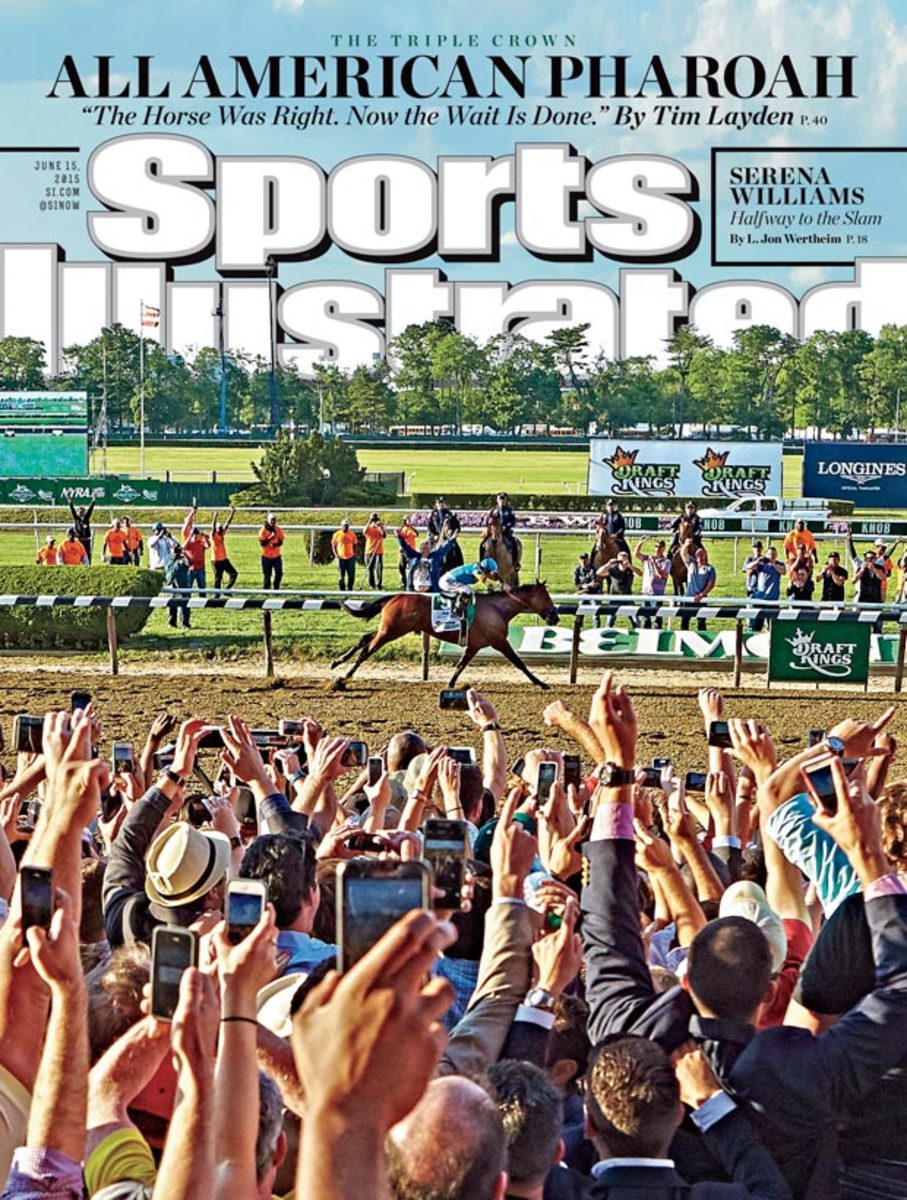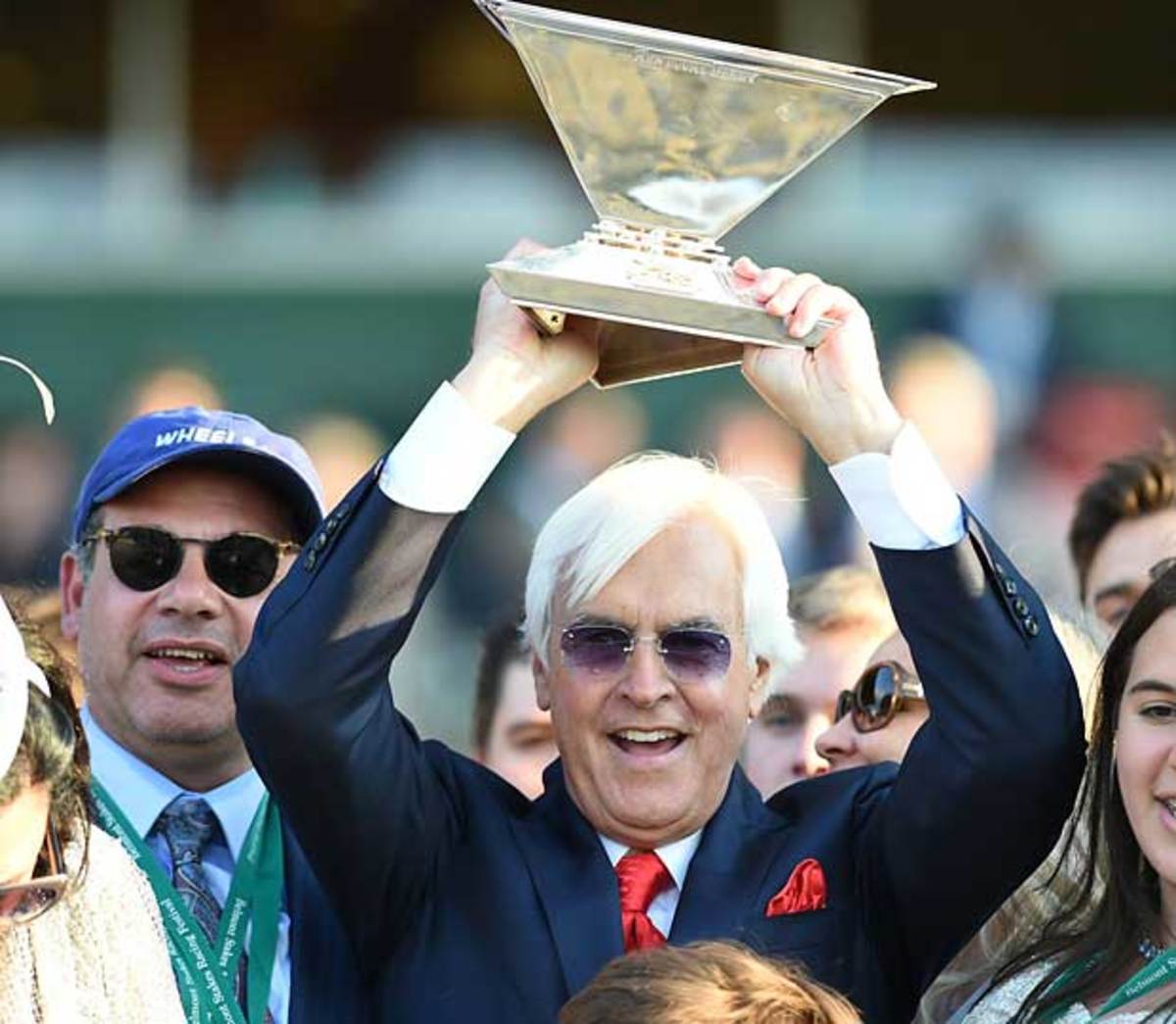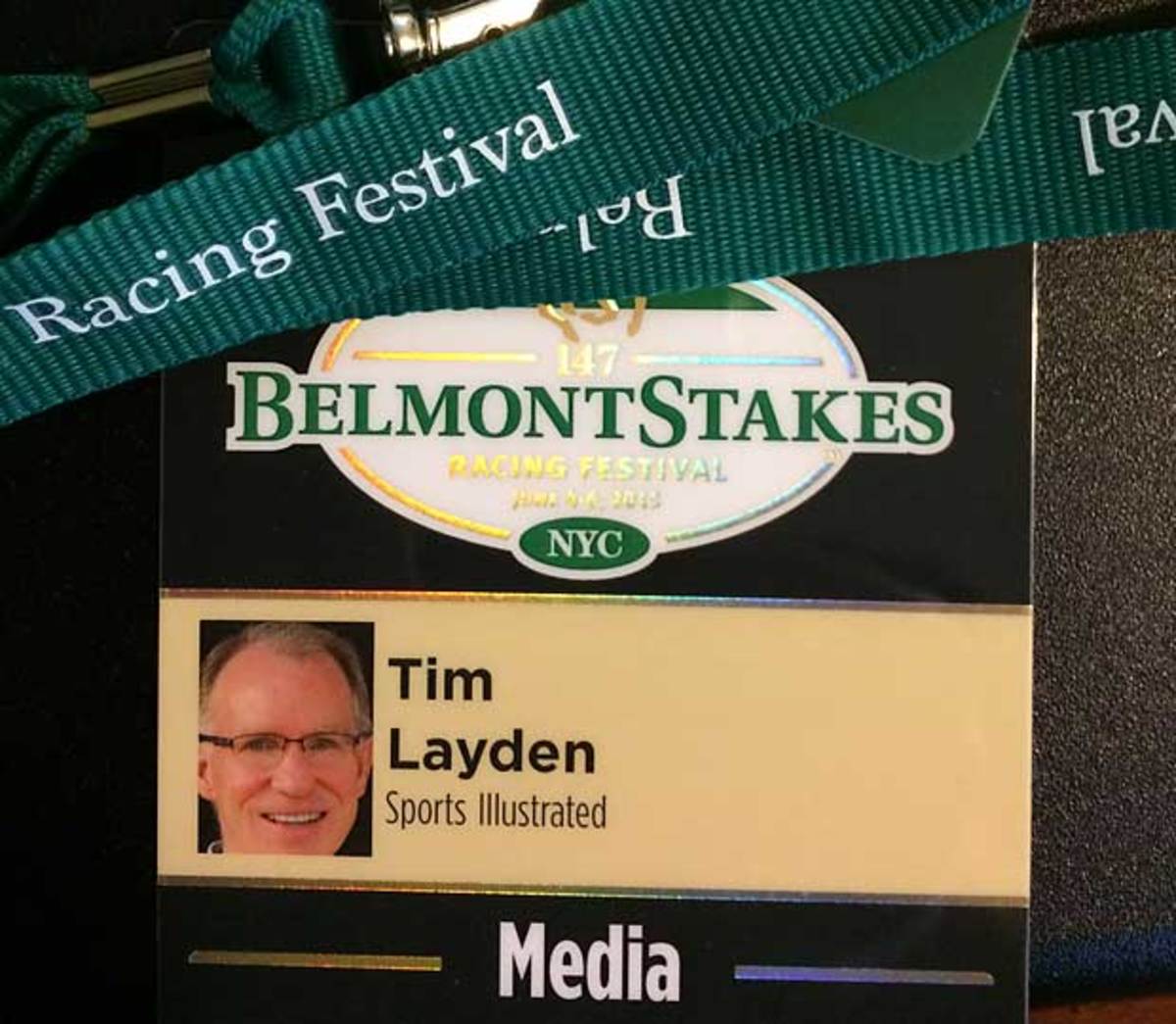American Pharoah, the Belmont and the making of a story for all time

It was a little before midnight when I walked out of Belmont Park last Saturday night after American Pharoah’s Triple Crown-clinching win in the Belmont Stakes. Maybe it was a little after midnight. I know it was 11:57 when I walked out of the press box, down the long-L-shaped hallway and into what might be the second-oldest elevator in any sports venue in the U.S. (The oldest might be at Pimlico Race Course, site of the Preakness; there’s a whole lot of old in horse racing.) So I’m guessing about the exact time, to some extent. Out of the elevator and into the paddock, past the statue of Secretariat and stall 5, where a little more than five hours earlier trainer Bob Baffert had placed the saddle on American Pharoah. It had been a long day. But a good day. One of the best. Here’s how it went:
9:25 a.m. Arrived at Belmont, a cool 9½ hours before post time. Triple Crown horse races are among the longest days in sportswriting. (I know, Boo-hoo, poor sportswriters.) Attempting to arrive at any point closer to post time risks traffic jams or a paucity of parking spots, even in the designated media lots. Here I defer to the wisdom provided long ago by my friend, Mark Blaudschun, the retired former Boston Globe writer. Standing in a hotel lobby many hours before a college football game, I complained to Blaudschun that we were going to have far too much time to kill at the stadium. Blaudschun said, “Well, you can wait there, or you can wait here.” And of course, waiting at the hotel, you just fret that something will go wrong en route. So you go early. You wait there.
American Pharoah: Re-living the Triple Crown winner's historic run
12:00 p.m.
The Belmont press box is a relic. This is true of most racetrack press facilities because, to be fair, for most of the year they are only needed by a small number of racing journalists. Churchill Downs, which has spent millions in track upgrades in recent years, doesn’t have a press box at all. During Kentucky Derby week, a windowless first-floor simulcast theater serves as the room. And it’s perfectly fine. For a Triple Crown bid, the Belmont press box is strained to the seams with impatient, over-caffeinated, time-killing journalists.
I found myself looking around the press box and wondering if there was even one journalist there who was also in attendance and working when Affirmed won horse racing’s last Triple Crown, in 1978. The first major horse race I covered was the infamous, disqualification-marred Affirmed-Alydar rematch in the 1978 Travers at Saratoga. I was two months out of college and working in upstate New York at the Schenectady Gazette. My seat in the press box was next to Red Smith. I remember thinking, “How am I supposed to write a story sitting next to Red Smith?”
Anyway. I was not at the 1978 Belmont. Who might have been? I started asking some of the other elders in the box. Mike Watchmaker of the Daily Racing Form? No. His colleague, Jay Privman? No. Bill Dwyre of the Los Angeles Times? Nope. Finally somebody suggested Jerry Izenberg, 84, who still writes columns on occasion for Newark’s Star-Ledger. Sure enough. “I was here for Affirmed,” Jerry told me. “And Secretariat (’73) and Seattle Slew (’77), too.” I kiddingly asked if he had also been on hand to see Citation win the Triple Crown in 1948. He had not. I tweeted out Jerry’s status, and then realized that perhaps Steve Haskin of the Blood-Horse, an industry publication, might have been at Belmont in ’78. Or perhaps Daily Racing Form columnist Jay Hovdey. Haskin later told me that he was in England for the ’78 Belmont (though he had seen Secretariat and Slew), while I never caught up with Hovdey. (Just before the race I found my friend, former Newsday handicapper/writer John Pricci, sitting in the box seats near American Pharoah’s trainer, Bob Baffert. In 1988, when I was at the Albany Times Union, Pricci helped me get hired at Newsday. It was a huge career move for me, and I will be forever thankful to him for that assistance. He was working at Belmont Park in ’78, but he was a spectator last Saturday).
So, getting to the point, there weren’t many journalists at Belmont on Saturday who had chronicled a Triple Crown.

SI,
Those days are gone. For many years, at big events, I’ve been writing stories on deadline for posting on SI.com.It’s a radically different exercise from heading back to the hotel, ordering room service and writing into the night. At the same time, I’m fortunate to have spent my first 16 years in the business working for morning newspapers, frequently on deadline, writing about as fast as I can type. Any newspaper writer knows what I’m talking about. For the 2015 Belmont, I had discussions with managing editor Chris Stone, executive editor Jon Wertheim and racing senior editor Mark Beech. I asked permission to write the race live for SI.com, on deadline, because I felt that was the time to write. I didn’t want to go back to the hotel and read others’ stories all night while knowing that mine would lay idle until Wednesday or Thursday. I offered to turn around and write a second story for the magazine on Sunday morning, with the caveat that I would hold nothing back from the live piece. So that was the plan.
Through the afternoon, I tried to outline and set up a strategy for writing a historic story. Pretty much everybody in the press box was doing the same thing, I’m sure, My goal was to write a magazine story, not a news story, and to write it as quickly and forcefully as possible within reasonable time constraints. Over the five weeks of the Triple Crown, Baffert had been generous in giving me time and access, going back to a visit I made to California in mid-April. (Props to my editors for green-lighting the trip; it proved crucial, even though at the time there was no guarantee that it would.) There were a few anecdotes from that access that I knew would be included in the story of American Pharoah winning the Triple Crown. I spent some time writing, rouging out a 750-word section that could, hopefully, stand as the middle of a longer story.
Among the anecdotes I hoped to use involved Team Baffert and its use of the Spanish slang word chingon, which came up frequently. Journalists are hard-wired to protect what they think—or know—might be exclusive information. At one point during Belmont week, when I was alone with Baffert, I said to him, “You’re a chatty guy. Do me a favor and let’s keep chingon between us.” He did, and I’m thankful for that, too. (In the last few days, I’ve heard some talk that chingon might have some unpleasant connotations, in addition to those that were explained to me, and which I found in research. I hope it’s not offensive; I tried hard to employ the word in that context it was being used at Baffert’s barn.)
Also, I tinkered with a first paragraph that might stand up if Pharoah won, but I didn’t have anything that really felt completely right, and that made me feel uncomfortable when I left the box to go cover the race. You like to have a security blanket when you are working on a tight deadline. But I’ve always found that sometimes I need an outcome to make things happen.
Los Angeles Times
At Baffert’s barn I ran into Mitch Covington, the vice president of sports marketing for Monster Energy, which had struck a sponsorship deal with American Pharoah’s owner, Ahmed Zayat. The day before, Covington talked with Baffert about putting Monster logos on American’s Pharoah’s bridle, reins or shadow roll. Baffert, not wanting to change anything about the horse’s equipment, had declined. They had reached a compromise: Pharoah would walk to the saddling paddock in a blanket with a Monster logo. But only if it wasn’t too warm. It was pretty warm. I wished Covington good luck, and also good luck with getting the “Monster Girls” near Pharoah in the paddock. Neither happened.
[pagebreak]

6:30 p.m.
Baffert took his seat and right behind him was a guy wearing a Burger King costume. Funny. After the Preakness, Baffert had told me that he turned down $150,000 to have the Burger King mascot stand next to him at Pimlico. Now here he was. I made eye contact with Baffert and he rolled his eyes toward the Burger King guy and smiled almost imperceptibly. “Took the money,” I thought. (On Sunday, Baffert texted me a photo of him and the King standing together with the message, “It’s good to be the king. LOL.” I found myself getting sick of Burger King and Monster and Draft Kings and Longines mucking up the Sport of Kings. But then again: Who cares? And there’s a cool ending. Baffert got $200,000 from Burger King and gave it to four equine charities.)
American Pharoah jockey, trainer donate Belmont winnings to charities
chingon
The race was a blur. I saw Pharoah bobble and then jump to the front. 24 seconds. 48 and something. 1:13 and change. Slow fractions. Jockey Victor Espinoza was hardly moving. Then in the stretch, Espinoza gave Pharoah his head and the horse opened three lengths, then four, then five. The noise was deafening, like nothing I’ve ever heard at a racetrack, and only in the loudest of college football stadiums or indoor arenas. It was a desperate noise, 90,000 fans all cheering for the same outcome and for their own place in history.
I had covered horse racing extensively in the 1980s for those upstate New York papers, and then sporadically for Newsday in the ’90s, backing up the late Paul Moran. I took over the beat at SI (it’s only a few weeks a year) when William Nack retired from the magazine in 2001. (I also followed the great Kenny Moore on the track beat; lucky me.) I covered eight of the previous 12 failed Triple Crown attempts in the Belmont Stakes—Alysheba in 1987, Sunday Silence in ’89, War Emblem in 2002, Funny Cide in ’03, Smarty Jones in ’04, Big Brown in ’08, I’ll Have Another in ’12 and California Chrome in ’14. In the final strides of the race last Saturday, I was swiveling my head back and forth between Baffert and track, finally fixing on the horse. I had only one thought: “This is actually going to happen.”
The aftermath of the race was chaotic, bordering at times on dangerous. That’s the way it gets with crowds. But I remember faces. As I chased Baffert and Zayat along the catwalk to the winner’s circle, people were crying and screaming, trying to touch the trainer and the owner. In the next hour, I would run into colleagues who had seen many of the same Triple Crown failures that I had. Our communication was almost all non-verbal. Hey, it’s not like we all went to war together, but we had been through some of the most crushing disappointments in racing history. A nod from Haskin. A smile from radio host Steve Byk. A shrug from my old Albany buddy, Tim Wilkin. We were all scrambling to work, to find voices that would lend perspective to the moment, but we were all, I’m sure, trying to process the moment.
The next hour was a whirlwind, I raced back and forth between the track and the tunnel, looking for authoritative words from somebody, anybody. At one point I stopped in the shade and scribbled a potential solution to the dilemma of how I was going to lead my story. Later I would wind up going with it. Crazy the way these things pop into your head.
On my last trip up the tunnel, toward the formal press conference, I stopped and thought about the dirt under my feet. This was where I stood next to Beech in 2004 and watched Smarty Jones get run down by Birdstone. This is where I crowded in four years later to hear jockey Kent Desormeaux explain why Big Brown stopped running. Only the day before, I had walked across the track to speak with my friend Bill Frakes, the great, longtime SI photographer, and as I walked up the tunnel I imagined that 24 hours later I would be shoving my way in front of Espinoza to ask how Pharoah had gotten beat. But the horse didn’t get beat. Finally. I felt a lump in my throat. Big baby.

11:57 p.m. Through the paddock and out to the car. Thinking about those failed Triple Crown stories and the beaten feeling afterward. Most sportswriters I know keep an unwritten list in their heads of the best events they’ve ever covered. For me: Mike Tyson’s first heavyweight title in 1986, Duke-UNLV in ’91, Christian Laettner’s shot in the ’92 NCAA tournament, Boston College–Notre Dame in ’93, the David Tyree’ catch in the Super Bowl in 2008, Usain Bolt in Beijing later the same year. Others, no doubt. This Belmont was right up there. Maybe at the top. I drove back to the hotel, went to the bar and had a couple beers with Forde, NBC’s Mike Kane, another old friend from my Albany days; and Darren Rogers from Churchill Downs. Tried to fall asleep at 3:15 a.m. No chance. Still buzzing.
Sunday, 8:45 a.m. I awoke to the prospect of writing another story, as I had promised. As I drove along the Southern State Parkway to a post-Belmont press conference, I thought of ways to shuffle my words around and make the story seem fresh, but all of them seemed likely to weaken a piece that I had already done. I emailed Stone, Wertheim and Beech and told them that I wasn’t confident that I could do better than what I had written the previous night, even with another 24 hours. Or 24 days. They agreed. I felt like a wimp, but an honest wimp. The story in this week’s SI, with American Pharoah on the cover, is virtually the same as the one I wrote in the press box after the race.
On Monday evening, Baffert sent me a text: “I will never forget the crowd noise.”
Nor will I.
